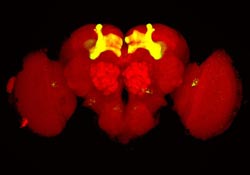Heidelberg Researchers Identify “Switch” for Long-term Memory

Brain of the “Drosophila melanogaster” fruit fly with its association and learning centres, called mushroom bodies, marked in green. A subgroup of the marked neurons carries out a switching function that creates long-term memory in the flies by controlling the production of "memory proteins" using a nuclear calcium signal.<br>Jan-Marek Weislogel, IZN, Heidelberg University, and Shamprasad Varija Raghu, Neuroscience Research Partnership, Singapore. With permission of Science Signaling/AAAS.<br>
Neurobiologists at Heidelberg University have identified calcium in the cell nucleus to be a cellular “switch” responsible for the formation of long-term memory. Using the fruit fly “Drosophila melanogaster” as a model, the team led by Prof. Dr. Christoph Schuster and Prof. Dr. Hilmar Bading investigates how the brain learns.
The researchers wanted to know which signals in the brain were responsible for building long-term memory and for forming the special proteins involved. The results of the research were published in the journal “Science Signaling”.
The team from the Interdisciplinary Center for Neurosciences (IZN) measured nuclear calcium levels with a fluorescent protein in the association and learning centres of the insect’s brain to investigate any changes that might occur during the learning process. Their work on the fruit fly revealed brief surges in calcium levels in the cell nuclei of certain neurons during learning. It was this calcium signal that researchers identified as the trigger of a genetic programme that controls the production of “memory proteins”. If this nuclear calcium switch is blocked, the flies are unable to form long-term memory.
Prof. Schuster explains that insects and mammals separated evolutionary paths approximately 600 million years ago. In spite of this sizable gap, certain vitally important processes such as memory formation use similar cellular mechanisms in humans, mice and flies, as the researchers’ experiments were able to prove. “These commonalities indicate that the formation of long-term memory is an ancient phenomenon already present in the shared ancestors of insects and vertebrates. Both species probably use similar cellular mechanisms for forming long-term memory, including the nuclear calcium switch”, Schuster continues.
The IZN researchers assume that similar switches based on nuclear calcium signals may have applications in other areas – presumably whenever organisms need to adapt to new conditions over the long term. “Pain memory, for example, or certain protective and survival functions of neurons use this nuclear calcium switch, too”, says Prof. Bading. This cellular switch may no longer work as well in the elderly, which Bading believes may explain the decline in memory typically observed in old age. Thus, the discoveries by the Heidelberg neurobiologists open up new perspectives for the treatment of age- and illness-related changes in brain functions.
Interdisciplinary Center for Neurosciences:
http://www.izn.uni-heidelberg.de
Prof. Bading’s research group:
http://www.uni-heidelberg.de/izn/researchgroups/bading
Prof. Schuster’s research group:
http://www.uni-heidelberg.de/izn/researchgroups/schuster
Original publication:
Weislogel, J. M., Bengtson, C. P., Müller, M. K., Hörtzsch, J. N., Bujard, M., Schuster, C. M., and Bading, H.: Requirement for Nuclear Calcium Signaling in Drosophila Long-Term Memory. Science Signaling 6 (274), ra33, 07 May 2013, doi: 10.1126/scisignal.2003598
Contact:
Prof. Dr. Hilmar Bading / Prof. Dr. Christoph Schuster
Interdisciplinary Center for Neurosciences
Phone: +49 06221 54-8218 / +49 6221 54-8300
hilmar.bading@uni-hd.de / schuster@nbio.uni-heidelberg.de
Communications and Marketing
Press Office, phone: +49 6221 54-2311
presse@rektorat.uni-heidelberg.de
Media Contact
More Information:
http://www.uni-heidelberg.deAll latest news from the category: Life Sciences and Chemistry
Articles and reports from the Life Sciences and chemistry area deal with applied and basic research into modern biology, chemistry and human medicine.
Valuable information can be found on a range of life sciences fields including bacteriology, biochemistry, bionics, bioinformatics, biophysics, biotechnology, genetics, geobotany, human biology, marine biology, microbiology, molecular biology, cellular biology, zoology, bioinorganic chemistry, microchemistry and environmental chemistry.
Newest articles

First-of-its-kind study uses remote sensing to monitor plastic debris in rivers and lakes
Remote sensing creates a cost-effective solution to monitoring plastic pollution. A first-of-its-kind study from researchers at the University of Minnesota Twin Cities shows how remote sensing can help monitor and…

Laser-based artificial neuron mimics nerve cell functions at lightning speed
With a processing speed a billion times faster than nature, chip-based laser neuron could help advance AI tasks such as pattern recognition and sequence prediction. Researchers have developed a laser-based…

Optimising the processing of plastic waste
Just one look in the yellow bin reveals a colourful jumble of different types of plastic. However, the purer and more uniform plastic waste is, the easier it is to…



